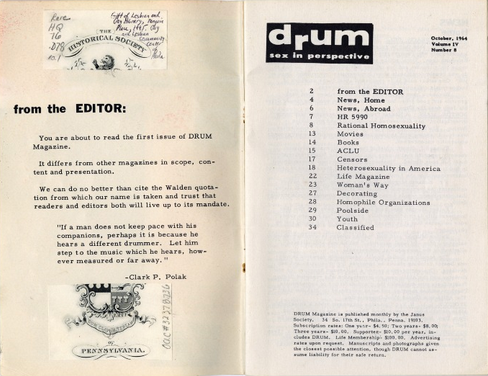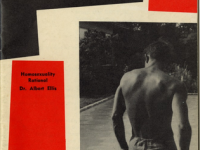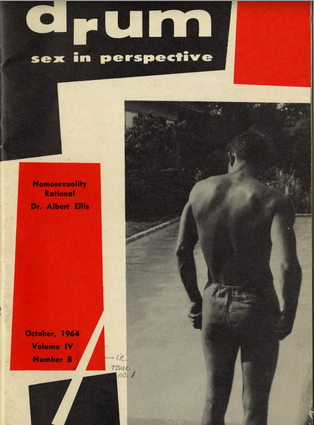HSP's Tyler Antoine explores one of the earliest gay magazines in the US, Drum, as part of a new blog series: "Beats of the Drum." Published here in Philadelphia in 1964, Drum represented a radical break from the past through its stark portrayals of homosexuals in mid-century America. For his inaugural post, Tyler discusses the immediate cultural milieu into which Drum emerged.
One of the more colorful items to be found in HSP’s Digital Library is the first issue of Drum, an early gay pride magazine first published by Clark Polak in Philadelphia in 1964. In this series, entitled “Beats of the Drum,” we aim to explore some of the more fascinating facets of this important document of LGBT history.
If you haven’t heard of Drum, you might be surprised at how much of a landmark magazine it was within mid-century gay American culture. First published in 1964, the climate in which the magazine appeared was hardly hospitable to homosexuals. Only six years had passed since the striking down of the Comstock laws forbidding the postage of homosexual materials.
In the early 1960s, homosexuality was still considered a mental disorder. The American Psychology Association listed homosexuality as a form of psychosis, recommended electric shock therapy, lobotomy, and other “treatments.” Far from the Equal Opportunity Employers of today, federal agencies were firing any employees suspected of being homosexual. Public LGBT demonstrations were few and far between, with the first Christopher Street Pride Parade still years away.
Put plainly, it was very dangerous to be gay at the time Drum appeared. There was a serious lack of visibility due to the threat of being outed. In this time of ubiquitous gay pride events – everything from parades to dance parties – it’s easy to forget how these traditions are steeped in a longtime struggle from near invisibility to visibility and an appreciation for the public figures and unsung heroes who paved the way for these traditions to become so accepted.
The cover of Drum's inaugural issue in October, 1964
This is why Drum magazine represents such a revolutionary break. Unlike preceding LGBT publications – such as lesbian publication The Ladder, which relied on innocuous covers without any visual hint as to what could be found inside – the cover for the first issue of Drum displays the back-end of a man wearing only his swim trunks. Despite its frank appearance, Drum boasted a monthly circulation of about 10,000 at its peak – the largest circulation number for any magazine of its kind at that time.
More salacious photos and spreads would follow in subsequent issues. In 1965, it became the first American magazine to feature a full-frontal male pictorial. Polak's fearless approach to sexuality would ultimately be his downfall, however. The magazine ended in 1969 after a raid of Clark Polak's offices, resulting in Polak being brought up on 18 counts of publishing and distributing obscene material via his Trojan Book Service -- particularly obscene films. His business destroyed, Clark Polak would leave Philadelphia the following year.

A note from editor Clark Polak & Thoreau's quote that inspired the magazine's title.
A seriously unsung hero, Polak was the founder of the Janus Society, an early homophile organization. After relocating to Los Angeles following his conviction, Polak continued a life of activism, founding a gay chapter at his local ACLU before ultimately taking his life in 1980. The alienation he and his homosexual brethren felt can be observed from the Thoreau quote from which Drum takes its namesake – “If a man does not keep pace with his companions, perhaps it is because he hears the beat of a different drummer.”


